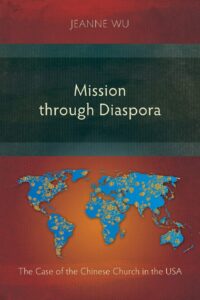Mission through Diaspora: The Case of the Chinese Church in the USA by Jeanne Wu. Langham Monographs, 2016, 202 pages. Paperback, ISBN-10: 1783681098; ISBN-13: 978-1783681099. Available from Langham Monographs and Amazon.
Diaspora mission has gained considerable attention in recent years with notable works such as Enoch Wan’s Diaspora Missiology (Portland, OR: Institute of Diaspora Studies, 2011) and Chandler Im and Amos Yong’s Global Diaspora and Mission (Oxford: Regnum Books International, 2014). These books highlight how opportunities in mission are related to diasporas in their diverse contexts. Engaging with this emphasis, Jeanne Wu’s book spotlights a case study of the Chinese diaspora, while using Enoch Wan’s category of “missions through the diaspora” to investigate the mission focus of US Chinese churches.
Wu’s book is structured as follows: chapter one introduces the evangelical attention to diaspora mission and the scope of the research covered in the book. Chapter two covers the relevant literature and offers definitions to terms such as globalization, diaspora (in general), Chinese diaspora, diaspora missiology, and short-term mission. Chapter three delineates the research methodology behind this work and provides data on the churches included in the study. This chapter also includes a brief discussion of the transnational connections of the Chinese diaspora as background to the Chinese diaspora mission. Chapter four consists of summative charts from the research data which show the emphasis on a same-ethnicity focus in mission among US Chinese churches. It also provides reasons that lead to this focus. Chapter five draws upon additional research data to reveal the unique characteristics of short-term mission conducted by these churches. This chapter describes the nature of mission through diaspora as seen in the short-term mission activities of US Chinese churches. Chapter six contains Wu’s reflections and recommendations for further research and mission direction of U.S. Chinese churches.
Some background information on Chinese migration and mission is helpful in understanding the significance of Wu’s study. On this note, it is important to recall that Chinese migration has a long history going back centuries—sometimes only for temporary sojourns and at other times resulting in permanent resettlement. Chinese migrants began to encounter Christianity in new lands around the same time that Western Protestant mission movements began to concentrate their efforts on China. Missionary zeal for China sometimes grew into a similar passion towards Chinese in the diaspora. Today, in the classic US Chinatowns and in postcolonial Southeast Asia, historic Chinese churches attest to this past in mission to diaspora populations. More recently, Chinese Christians in migration have also brought their faith with them, setting up new Chinese churches wherever they go, often converting other diasporic Chinese and thus adding to their numbers. In both older and newer models of diaspora mission, the Chinese diaspora either serves as the recipient of Christianity, or their evangelistic efforts are oriented toward those like themselves in the same region.
In this book, however, Wu shows that Chinese churches in the US have progressed from being receivers to senders in diaspora mission, with ministry activities of their own in “mission through diaspora” (emphasis mine). Using short-term missions as an investigative lens, Wu uses a quantitative approach with some follow-up interviews to explore the missional priorities and activities of the Chinese church in the US. Results from surveys she collected from 317 churches confirm the general perception that Chinese churches in the US tend to put their resources into missions to ethnic Chinese (73% list missions to Chinese as top priority, p. 83)—both in China and in other countries. Because of this same-ethnicity focus, short-term mission trips originating from US Chinese churches have characteristics that differ from the approaches of US megachurches and US Korean churches.
Wu explains this focus on the same ethnicity with a threefold logic: The spiritual needs of a non-Christian majority among ethnic Chinese (p. 83), existing transnational Chinese networks (pp. 95, 97), and the advantage of sharing the same language (p. 100). She also emphasizes the same-language advantage in shaping the short-term mission’s orientation toward verbal communication of the Christian faith with attention given to discipleship training and teaching the Bible (32.4%), evangelism and church planting (23.8%), and children’s ministries and VBS (18.6%) (pp. 129-130). Wu uses these dynamics to show the differences in short-term missions between US Chinese churches on the one hand, and US megachurches and US Korean churches on the other.
This work, which is based on Wu’s PhD dissertation from Trinity International University (Deerfield, IL), is filled with useful data on the mission attitudes and behaviors of US Chinese churches in her survey sample. Other quantitative data in the book, such as regional representation, denominational background, languages used, and congregational size, provide additional information on the makeup of US Chinese churches. Though this study was conducted in 2013, much of its information likely remains applicable today. One possible weakness of the plenitude of data, however, is that the overwhelming number of charts can sometimes be more distracting than helpful.
In my estimation, the most fascinating aspect of this book is Wu’s own reflections on the same-ethnicity mission focus found in US Chinese churches. She confesses to a change in her perspective on why these churches hold to this focus. Wu writes, “Before I started this research project, my reasoning for the mission approach of Chinese churches was simply ‘ethnocentrism.’ But after careful research, I discovered that the cause behind this kind of mission practice is more complicated than ethnocentrism” (pp. 157–8). By sharing her own journey, Wu helps readers understand why a same-ethnic mission focus may still have a place in diaspora mission, thus adding nuance to the contemporary mission focus on unreached people groups (as outlined by missiologist Ralph Winter at Lausanne 1974).
Although Wu is charitable about the tendency of US Chinese churches to focus on mission to Chinese people, she also recommends that these churches go further. Wu advocates beginning with mission to Chinese in their localities, then expanding outward to include mission to Chinese in other places around the world, and finally to serving non-Chinese globally. Wu’s exhortation for the Chinese Christian diaspora to participate more fully in the Great Commission is salutary and worthy of attention.
In conclusion, this book showcases mission attitudes and activities among Chinese churches in the US. The detailed data provide in-depth explanations that simultaneously confirm the impression of a same-ethnicity focus in mission while offering more nuanced reasons why such a focus can be advantageous. For these reasons, Wu has provided a useful book for anyone who seeks a more thorough understanding of Chinese diaspora missions.
Image credit: Joann Pittman.

Jackie J. Hwang
Jackie Hwang is a Taiwanese American whose journey has taken her from Asia to the US then back to Asia. She considers herself a global citizen whose home is everywhere and nowhere. She has served with OMF International since 2010 in both Singapore and the US. She is currently a …View Full Bio
